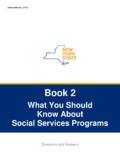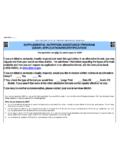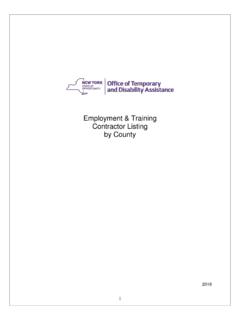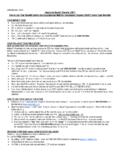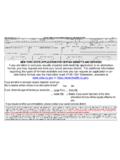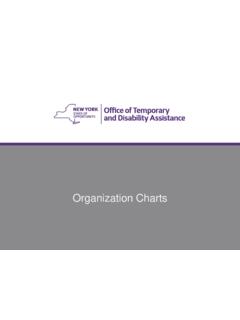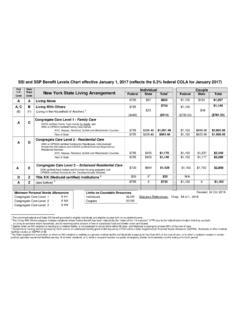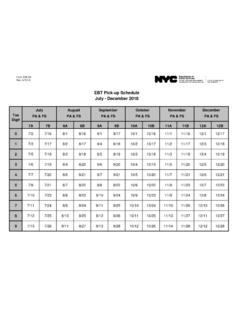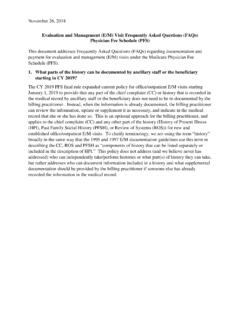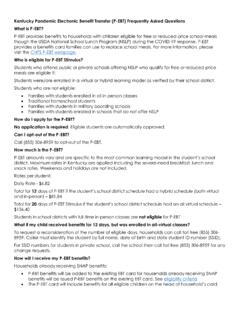Transcription of ERAP Frequently Asked Questions - otda.ny.gov
1 ** Indicates a newly added or revised question and answer ERAP Frequently Asked Questions Benefits Available and Who is Eligible Application Processing Assistance for Tenants not Eligible for ERAP. Landlord / Property Owner Considerations Tenant Protections Other Systems Access Benefits Available and Who is Eligible 1. What is the Emergency Rental Assistance Program and what help does it provide? The Emergency Rental Assistance Program (ERAP) is an economic relief program developed to help eligible households residing in at their primary residence in New York State request assistance for rental and utility arrears accumulated during the COVID-19 crisis. The program will provide significant economic relief to low- and moderate-income tenants and will help landlords obtain rents due. Approved applicants may receive: Up to 12 months of rental arrears payments for rents accrued on or after March 13, 2020. Up to 3 months of additional rental assistance for future rent if the household spends 30 percent or more of its gross monthly income to pay for rent and if the household also applies for rental arrears payments.
2 Up to 12 months of electric or gas utility arrears payments for arrears that have accrued on or after March 13, 2020 if the household also applies for rental arrears payments. Payments will be made directly to the landlord/property owner and utility company on behalf of the tenant. Tenants, landlords/property managers and utility companies will be notified of the amounts paid on their behalf. If a landlord is difficult to locate or does not otherwise provide information needed to complete the application after initial outreach efforts, funds will be held for 180 days to allow enough time to locate the landlord and collect required information, as well as to provide tenant protections and maximize landlord participation. 2. Am I eligible for the Emergency Rental Assistance Program (ERAP)? Tenants in New York State may be eligible for ERAP if all the following apply: For the federally-funded ERAP program, household gross income is at or below 80. percent of the Area Median Income (AMI).
3 These income limits differ by county and New York State Office of Temporary and Disability Assistance January 25, 2022 1. household size. A household may qualify based on either current monthly income or calendar year 2020 income that is at or below 80 percent AMI. starting September 15, 2021, household gross income is at or below 120 percent of the Area Median Income (AMI). These income limits differ by county and household size. A. household may qualify based on current income or calendar year 2020 income that is at or below 120 percent AMI. Households with income above 80% AMI are eligible for a State-funded ERAP payment so long as funds remain available. On or after March 13, 2020, a member of the household received unemployment benefits or experienced a reduction in household income, incurred significant costs or experienced other financial hardship, directly or indirectly, due to the COVID-19. pandemic. The applicant is obligated to pay rent and has rental arrears (rent overdue) at their current residence for rent owed on or after March 13, 2020.
4 The household is at risk of experiencing homelessness or housing instability, which can be demonstrated by having rental arrears owed on or after March 13, 2020. There are no immigration status requirements to qualify for the program. Important Note Regarding Priority Application Processing For the federally-funded ERAP program, for applications received during the first 30 days of the program, from 6/1/21-6/30/21, priority was given to households in the following order: 1. Households with income at or below 50 percent of the Area Median Income (AMI) that also include a household member who: o Is currently unemployed for at least 90 days; or o Is a veteran; or o Is experiencing domestic violence or is a survivor of human trafficking; or o Has an eviction case related to their current residence pending in court; or o Resides in a mobile home; or o Lives in a community that was disproportionately impacted by COVID-19; or o Lives in a dwelling of 20 or fewer units. 2. Households with income at or below 50 percent AMI.
5 3. Households with income at or below 80 percent AMI that also include a household member who: o Is currently unemployed for at least 90 days; or o Is a veteran; or o Is experiencing domestic violence or is a survivor of human trafficking; or o Has an eviction case related to their current residence pending in court; or New York State Office of Temporary and Disability Assistance January 25, 2022 2. o Resides in a mobile home; or o Lives in a community that was disproportionately impacted by COVID-19; or o Lives in a dwelling of 20 or fewer units. 4. Households with income at or below 80 percent AMI. After 6/30/21 (the first 30 days), applications for all eligible households are processed on a first- come, first-served basis, as long as funds remain available. starting September 15, 2021, households with income up to 120% of the AMI may apply for the program so long as State funds remain available Applications for households with income up to 100% of the AMI were processed on a first-come, first-served basis through October 29, 2021.
6 Applications for households with income up to 120% of the AMI are being processed on a first-come, first-served basis starting October 30, 2021. 3. I am a landlord and my tenant left the rental property or isn't willing to apply for ERAP. Am I eligible for assistance? **. Yes. State law was passed that creates the Landlord Rental Assistance Program (LRAP), another new program to provide rental assistance for landlords whose tenants have left their rental property or who are unwilling to apply for ERAP. As of November 21, 2021, LRAP is no longer accepting applications for assistance. 4. What are examples of financial hardship experienced due to the COVID-19 pandemic? Direct or indirect financial hardship experienced as a result of COVID-19 may include (but is not limited to): Reduction in household income, such as: o Reduced wages/earnings o Reduced hours o Employment termination o Furlough o Sickness and inability to work o Business closed o Receiving unemployment Increased household expenses, such as: o New or increased healthcare costs o Remote work expenses due to COVID-19.
7 O Food, medicine, childcare, transportation expenses due to COVID-19. o Penalties, fees and/or legal costs associated with rental or utility arrears New York State Office of Temporary and Disability Assistance January 25, 2022 3. o At-home care for someone with COVID-19. o Remote learning expenses due to COVID-19. o Purchase of Protective Personal Equipment (PPE). o Payments made by credit card or loans to avoid homelessness o Alternative Transportation arrangements due to COVID imposed transportation limitations o Funeral expenses 5. Do I need to have lawful immigration status to be eligible to receive rental assistance? No. Individuals do not need to have a lawful immigration status to qualify for the program. 6. How will eligible ERAP households receive utility arrears relief? For households determined eligible for ERAP who also have gas and/or electric utility arrears, there are a few ways households may receive assistance in paying these utility arrears: First, a utility arrears payment made directly to the utility company funded through by Home Energy Assistance Program (HEAP), for those eligible for HEAP (view HEAP.)
8 Eligibility information);. If households are not eligible for HEAP, eligibility for one of the following two options will be evaluated based on the type of utility company that the household uses: o Forgiveness of utility arrears by the utility company; or o A utility arrears payment made directly to the utility company funded through ERAP. 7. Can I apply for utility arrears assistance only? No. An individual must apply for and be determined eligible for ERAP rental arrears assistance in order to receive utility arrears assistance through the ERAP. New York State residents outside of New York City who do not need help paying for rental arrears and only need help paying for utility costs should apply for the Home Energy Assistance Program (HEAP). at Individuals residing in New York City can download an application from the NYC Human Resources Administration HEAP webpage. 8. Are water bills or internet bills eligible as part of ERAP? No, only gas and/or electric utility arrears may be paid for households determined eligible for rental arrears assistance under ERAP.
9 9. What happens to utility costs that are included in the rent? If utility expenses are part of a household's monthly rental costs and a household does not receive a separate gas or electric utility bill, the utility expenses would be included as part of the rental arrears. New York State Office of Temporary and Disability Assistance January 25, 2022 4. 10. If my gas and/or electricity utility is sub-metered and billed on my rental statement from my landlord, building management company or from a third-party contracted billing company, how do I include unpaid utility charges on my ERAP application? **. Sub-metered gas and/or electricity unpaid charges should be included as rental arrearages and will be paid directly to your landlord, building management company or from a third-party contracted billing company. 11. Are electrical utility arrears for tenants who live in sub-metered apartments eligible for ERAP? Yes, with acceptable documentation. 12. For what time period is my household income counted to determine if I am eligible for ERAP assistance?
10 **. Tenant applicants may choose to submit documentation indicating current monthly income or calendar year 2020 income. Current Monthly Income by providing documentation of prior month income through documents such as pay stubs, bank account deposit verification, unemployment insurance benefits letter, Social Security award letter, other. OR. Annual 2020 Income by documentation of 2020 income through documents such as a copy of a completed income tax return such as a 1040, 1040EZ, 1099 tax form, or other evidence of 2020 annual income. Self-attestation of income, through a written and signed statement, is permitted in certain circumstances where no documentation is available, such as certain types of self-employment. 13. What income is included when determining my household income for ERAP? Income of all adults in the household 18 years of age or older is counted except earned income of full-time students who are eligible to be claimed as a dependent pursuant to IRS regulations.
